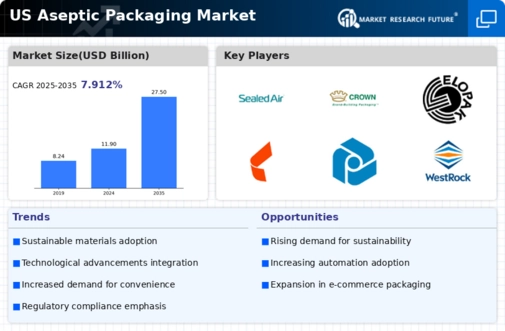Health and Safety Regulations
The aseptic packaging market is significantly influenced by stringent health and safety regulations imposed by government agencies in the US. These regulations are designed to ensure that food and beverage products are safe for consumption, which has led to an increased adoption of aseptic packaging solutions. The market is projected to grow at a CAGR of approximately 7.5% from 2025 to 2030, driven by the need for compliance with these regulations. As consumers become more health-conscious, manufacturers are compelled to adopt packaging that extends shelf life while maintaining product integrity. This trend is particularly evident in sectors such as dairy and juices, where the demand for safe, long-lasting products is paramount. Consequently, the aseptic packaging market is likely to see a surge in innovations aimed at meeting these regulatory standards.
Innovation in Packaging Materials
Innovation in packaging materials is a key driver of growth in the aseptic packaging market. Advances in materials science have led to the development of new, lightweight, and sustainable packaging options that enhance product protection and shelf life. For instance, the introduction of biodegradable and recyclable materials is gaining traction among manufacturers who aim to meet consumer demands for environmentally friendly solutions. This shift is reflected in the market, where the use of innovative materials is projected to increase by approximately 10% over the next five years. As companies strive to differentiate their products, the aseptic packaging market is likely to see a surge in the adoption of these advanced materials, which not only improve functionality but also align with sustainability goals.
Growth of E-commerce and Online Retail
The rapid expansion of e-commerce and online retail channels is reshaping the landscape of the aseptic packaging market. As more consumers turn to online shopping for their food and beverage needs, the demand for packaging that ensures product safety during transit has intensified. Aseptic packaging provides an effective solution by maintaining product quality and extending shelf life, which is crucial for online sales. Recent statistics indicate that e-commerce sales in the food and beverage sector have increased by over 20% in the past year. This trend is likely to continue, prompting manufacturers to invest in aseptic packaging technologies that cater to the needs of online retailers. The aseptic packaging market is thus expected to experience robust growth as it adapts to the evolving dynamics of consumer purchasing behavior in the digital age.
Rising Demand for Ready-to-Drink Products
The increasing demand for ready-to-drink (RTD) products is significantly impacting the aseptic packaging market. As busy lifestyles become the norm, consumers are gravitating towards convenient beverage options that require no preparation. This trend is particularly evident in the beverage sector, where products such as iced teas, flavored waters, and smoothies are gaining popularity. The aseptic packaging market is well-positioned to cater to this demand, as it allows for the safe and efficient packaging of RTD products. Recent market analysis suggests that the RTD beverage segment is expected to grow by approximately 12% annually, further driving the need for effective packaging solutions. Consequently, manufacturers are increasingly investing in aseptic technologies to meet the rising consumer expectations for quality and convenience.
Consumer Preference for Shelf-Stable Products
There is a notable shift in consumer preferences towards shelf-stable products, which is driving growth in the aseptic packaging market. As consumers increasingly seek convenience and longer shelf life, manufacturers are responding by utilizing aseptic packaging technologies. This trend is particularly pronounced in the dairy and beverage sectors, where products such as milk and juices are packaged to remain fresh without refrigeration. According to recent data, the demand for shelf-stable products has risen by approximately 15% in the last year alone. This consumer behavior not only enhances the market potential for aseptic packaging but also encourages manufacturers to innovate and improve their packaging solutions. The aseptic packaging market is thus positioned to benefit from this evolving consumer landscape, as it aligns with the growing demand for products that offer both convenience and quality.






















Leave a Comment